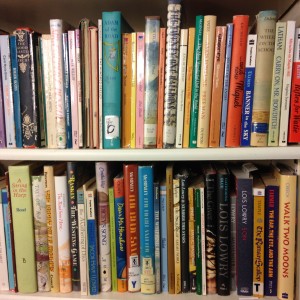By Rondi Sokoloff Frieder
 During my revision process, I try to read my works-in-progress to actual children. These willing guinea pigs have mostly been my loving sons and adoring first graders. Unfortunately, their reactions are often overly positive. “What’s wrong with those editors, Mom? Your story is awesome!” or “I loved it, Ms. Rondi. It was so funny!” And although these comments make me feel great about my writing, they rarely help me improve my books.
During my revision process, I try to read my works-in-progress to actual children. These willing guinea pigs have mostly been my loving sons and adoring first graders. Unfortunately, their reactions are often overly positive. “What’s wrong with those editors, Mom? Your story is awesome!” or “I loved it, Ms. Rondi. It was so funny!” And although these comments make me feel great about my writing, they rarely help me improve my books.
But this year, I had two “constructive” experiences. The first one happened when I asked a writer friend if she’d be willing to critique my middle-grade novel. She said yes, and then wanted to know if she could share the book with her eleven-year-old daughter who was extremely interested in my novel’s time period –World War II. I said yes, but knew better than to expect a great deal of useful feedback. Still, I printed out a hard copy of the manuscript, came up with a page of questions for her to answer, and dropped the binder off at their house.
In a little less than a week, I received an email from my young reader. “Hi Rondi! Is it okay if I write on the manuscript?” This was encouraging. It sounded like she was really digging in and taking the critique process seriously. I wrote back and told her I welcomed her comments and to write away. But deep down, I was a little worried. She was only at the beginning of my book and already making notes. Was it in worse shape than I thought?
In a few weeks, I got an email from my friend saying that although she still needed more time with my pages, her daughter had completed her critique. “She couldn’t put the book down!” were the exact words. This was good news, right? You didn’t zip through a boring book. But I could be wrong. She could have gotten all caught up in the editing process and ripped my words to shreds. All I knew was that the manuscript was ready to be picked up so I dashed to the store, bought a thank-you gift card, and drove to their house.
When we sat down in the family room together, I opened the black binder, not knowing what to expect. Here’s a sample of what I found:
1.The names of these two characters confused me. You should think about changing them.
2. How is this person related to the main character? You should tell us right away.
3. We met this character in chapter 1 so you should change the name of chapter 2.
4. You should explain this earlier in the story.
5. You use some big words here that readers may not understand.
I was blown away. Her comments were sophisticated, specific, and helpful. She had taken the time to think about the nitty gritty details of my story and given me suggestions on how to make the book stronger.
There were also thoughtful compliments:
- I like how you added an author’s note so I knew the story was based on your mom’s life.
- Thanks for adding a glossary so people will know what the Yiddish and Italian words mean.
And last, but not least, the accolades:
- This book rocks!
- Great job!
- This is one of the best books I’ve ever read!
This young reader had turned out to be a fabulous editor! She was well-read in my genre, the same age as my protagonist, and didn’t know me well enough to worry about pleasing me. But more importantly, she had taken her job seriously and giving me an honest critique with positive overtones. It was a winning combination.
The next opportunity to “child-test” my work came when I was invited to do a lesson on “Creating Interesting Characters” in a second grade classroom. Before I read my first chapter to the students, I had their teacher (my former first grader!) interview me as my main character. I had modified the list of questions I often use myself. This immediately drew the children into the life of my protagonist, especially when I tried to sound like an eleven-year-old! And although they were an attentive and engaged audience, I instantly became aware of some glaring problems in the manuscript. There were places where the dialogue was too long and sections with excessive narration and not enough action. I made notes, immediately. But here’s the best part… when I finished reading, their hands shot up and the questions flew. “What happens next? Does Shirley get to sing on the record? Is the new boy a bad guy?” They were hooked. I knew I still had work to do, but the foundation of my story was undeniably solid. “Well,” I said, smiling. “When the book is published, you’ll just have to read it and find out!”
Have you had similar experiences when sharing your work with children? If so, I’d love to hear about them!
